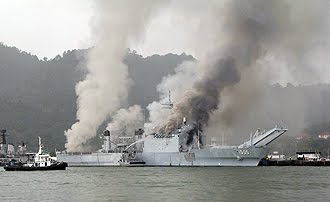From Friend in Navy
Through Hussein Hamid

Surprised? Shocked?
No I am not surprised because a ship sustained fire damage. Fire on board is indeed a normal thing. What I am surprised at is that it took a time-consuming eight-hours before the fire was brought under control! Eight hours! Surprised because the ability to fight and control any fire on board a Navy Vessel is ingrained and drummed into sailors on a daily basis. And I am shocked that despite this the destruction of KD Inderapura is so severe that the ship is categorized as ‘beyond economical repair’ (BER).
KD Rahmat, a ’state of the art’ (then) frigate tailor-made specifically by the Malaysian government in the mid sixties (originally the KD Hang Jebat) frequently also experienced the same problems. A number of fires occurred while it was still under construction and even after it was handed over to RMN. However it is not as bad as that which befell KD Seri Inderapura.
If fact the fire incidents on KD Rahmat is the highest amongst all ships within the RMN.
KD Rahmat was completed three years later then scheduled. In fact KD Rahmat spend more time berthed at the Malaysian Base Jetty (MBJ) Woodlands then going on maneuvers. During 1976 to 1977, KD Rahmat spent only about one month at sea, sailing through the South China Sea in Sabah waters and Sarawak. It was also open to the public in Rejang, Labuan and Tawau.
If my memory serves me right three fires occurred in that year which involved the generator, switchboard and the engine turbine. However these fires were brought under control within a very short time because of the ability of its crew to handle the emergency situations.
TLDM personnel from Lumut can surely still remember how every evening, training or ‘drill’ fire fighting is done on a daily basis. In KD TLDM base Malaya in Woodlands at 5 o’clock in the afternoon the duty ‘officer of the day’ (OOD) will direct lascar work while all gathered before the nearby fire-brigade office. If you failed to meet the target time, OOD will direct it to be done again. And again. And repeated until done right!
This fire fighting drill is drummed into us on a daily basis because our ability to do this drill well will determine the safety of our Navy Vessels and the lives of its crew.
Fire fighting drill training was also practised on board our vessels. Names such as Lt Ooi more known as ‘zero zero one’, Lt Teoh from RMNVR and Lt Khusaini are some of those OOD who were much revered and respected for their firmness and insistence that these drills must be done the correct way. These officers do not compromise on any aspect of the training. There will not accept that “this …OOD ok. He slipshod aje…”. They understood that in fighting a fire on board a vessel every second is critical. The better the ‘fire fighters’ the better their ability to minimize destruction level.
Are there still Officers of this caliber in the Navy? Or are these Fire Fighting” drills being practised purely as a routine exercise without drumming into the trainees the critical aspect of their work – that time was critical in saving a Ship and lives? That their prowess as fire fighters will make the difference between saving a ship or will mean its destruction? It would seem that these exercises are now being carried out without the dedication and commitment present during the time of those officers that I have mentioned before.
Maybe that was the difference between KD Rahmat and KD Seri Inderapura?
Usually, each ‘compartment’ in a ship will have its own portable fire extinguisher tool. The effectiveness of these fire extinguisher tools will depend on the ability of its fire fighters to do their work. A well-trained crew will be able to do their work in a controlled and rational way and will be able to bring a fire under control in the shortest possible time.
If the ‘fire fighters’ within KD Seri Inderapura were able to effectively use these fire extinguisher tools placed in their strategic ‘passage way’ and use the available roll hose fire extinguisher which uses sea water – then with these fire-fighting tools and well-drilled fire fighters, KD Seri Inderapura would still be with us today.
The question today is were the ‘fire fighters’ within KD Seri Inderapura adequately trained? Why did it take eight hours for the fire on board to be brought under control? Were the water pump and the motors working when needed? Were the maintenance level and attitude of the personnel on board KD Seri Inderapura wanting in their ability to meet an emergency situation as the one that occurred and resulted in its demise?
These are the questions that the Navy needs to answer or has it been answered with the demise of KD Seri Inderapura?
Answers are needed here and this matter should not be swept under the carpet again.